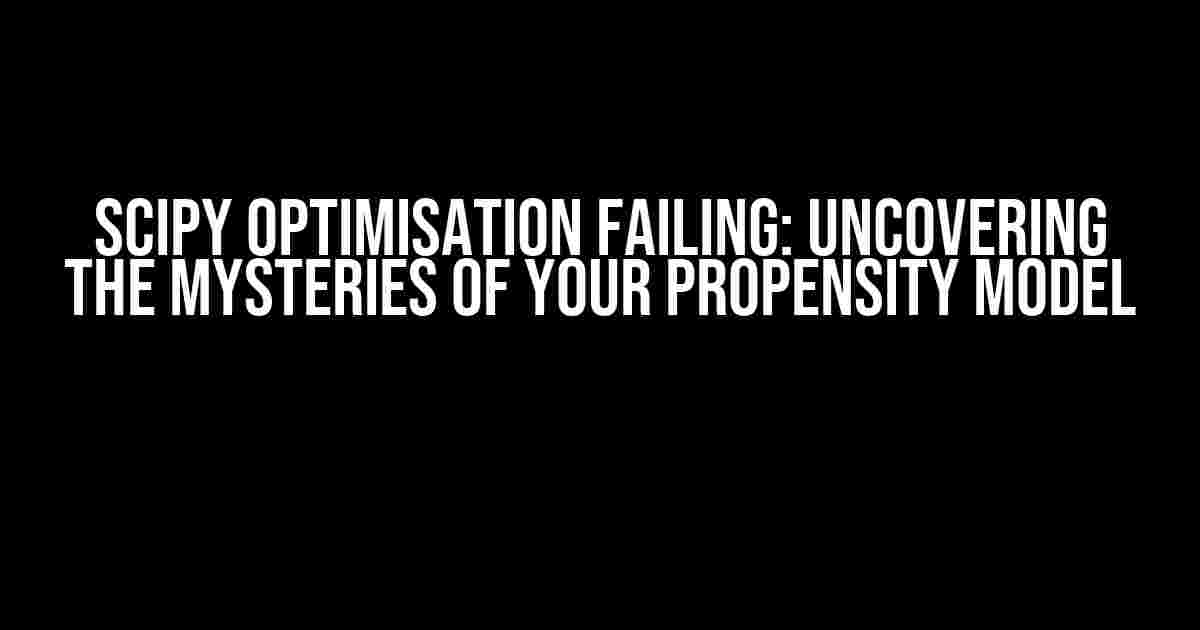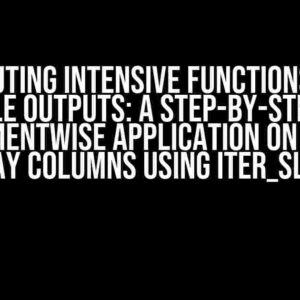Are you struggling with a propensity model that’s just not cooperating? You’re not alone! Scipy optimisation failing can be a frustrating and mystifying experience, especially when you’re confident that your model is sound. In this article, we’ll dive deep into the possible reasons why your propensity model is failing and provide you with actionable steps to get it back on track.
Understanding Propensity Models
Before we dive into the nitty-gritty of Scipy optimisation, let’s take a step back and review what propensity models are and why they’re so important. A propensity model is a statistical model that predicts the likelihood of a customer or user taking a specific action, such as making a purchase or clicking on an ad. These models are essential in many industries, including marketing, finance, and healthcare, as they help businesses identify high-value customers and target their efforts more effectively.
The Anatomy of a Propensity Model
A typical propensity model consists of three main components:
- Features: These are the input variables that are used to train the model, such as demographic data, behavioral data, and transactional data.
- Algorithm: This is the statistical method used to analyze the features and predict the propensity score. Common algorithms include logistic regression, decision trees, and random forests.
- Optimisation: This is the process of fine-tuning the model’s hyperparameters to achieve the best possible performance. This is where Scipy optimisation comes in!
Why is Scipy Optimisation Failing?
So, you’ve built your propensity model, and it’s not performing as expected. You’ve tried tweaking the hyperparameters, but nothing seems to work. It’s time to dig deeper and identify the root causes of the issue. Here are some common reasons why Scipy optimisation might be failing:
1. Poor Data Quality
Data quality is a critical component of any machine learning model. If your data is incomplete, inconsistent, or inaccurate, your model will struggle to produce reliable results. Check your data for:
- Missing values: Are there any gaps in your data that need to be filled?
- Noisy data: Are there any outliers or anomalies that need to be removed?
- Data imbalance: Is your data skewed towards one class or category?
2. Insufficient Data
Having too little data can be just as problematic as having poor data quality. If you don’t have enough data to train your model, it may not be able to learn meaningful patterns and relationships. Consider:
- Collecting more data: Can you gather more data from other sources or through additional data collection efforts?
- Using data augmentation: Can you generate synthetic data to supplement your existing data?
3. Inadequate Feature Engineering
Feature engineering is the process of selecting and transforming raw data into features that are suitable for modeling. If your features are not well-engineered, your model may not be able to learn effectively. Ask yourself:
- Are my features relevant and meaningful?
- Have I considered non-linear transformations and interactions?
- Are my features properly scaled and normalized?
4. Inappropriate Algorithm Choice
The algorithm you choose can have a significant impact on the performance of your propensity model. If you’re using an algorithm that’s not well-suited to your data, you may need to try a different approach. Consider:
- Linear models: Are you using a linear model for a non-linear problem?
- Tree-based models: Would a decision tree or random forest be a better fit?
- Neural networks: Could a neural network be used for more complex relationships?
5. Suboptimal Hyperparameters
Hyperparameters are the knobs and dials that control the behavior of your algorithm. If you’re not using the optimal hyperparameters, your model may not be performing at its best. Try:
- Grid search: Exhaustively searching for the optimal hyperparameters.
- Random search: Randomly sampling the hyperparameter space.
- Bayesian optimisation: Using a probabilistic approach to optimise hyperparameters.
Scipy Optimisation Best Practices
Now that we’ve covered some common pitfalls, let’s dive into some best practices for Scipy optimisation. By following these guidelines, you can increase the chances of success for your propensity model:
1. Define Clear Objectives
Before optimising your model, define clear objectives and performance metrics. This will help you focus on what matters most and ensure that you’re optimising for the right outcomes. Consider:
- AUROC (Area Under the Receiver Operating Characteristic Curve)
- Log loss
- F1 score
2. Choose the Right Optimiser
Scipy offers a range of optimisers, each with its strengths and weaknesses. Choose an optimiser that’s well-suited to your problem and data. Some popular options include:
- Gradient descent
- Quasi-Newton methods
- Conjugate gradient
3. Select Appropriate Initial Conditions
The initial conditions of your optimiser can have a significant impact on its performance. Choose initial conditions that are reasonable and informed by your domain knowledge. Consider:
- Random initialisation
- Grid-based initialisation
- Domain expertise-based initialisation
4. Monitor Convergence
Convergence is a critical aspect of optimisation. Monitor your optimiser’s progress and adjust as needed. Consider:
- Convergence criteria: Define a stopping criterion based on performance metrics.
- Learning rate schedules: Adjust the learning rate to improve convergence.
- Regularisation: Add regularisation terms to prevent overfitting.
5. Visualise and Interpret Results
Visualising and interpreting your results is crucial for understanding your model’s performance and identifying areas for improvement. Use techniques such as:
- ROC curves
- Confusion matrices
- Feature importance plots
Example Code: Scipy Optimisation for Propensity Models
import numpy as np
from scipy.optimize import minimize
from sklearn.linear_model import LogisticRegression
from sklearn.metrics import roc_auc_score
# Load data
X_train, y_train, X_test, y_test = load_data()
# Define propensity model
model = LogisticRegression()
# Define objective function
def objective(params):
model.coef_ = params[0].reshape(1, -1)
model.intercept_ = params[1]
y_pred = model.predict_proba(X_train)[:, 1]
loss = -roc_auc_score(y_train, y_pred)
return loss
# Define initial conditions
init_params = np.random.rand(2 * X_train.shape[1])
# Define bounds
bounds = [(None, None) for _ in range(2 * X_train.shape[1])]
# Define optimiser
res = minimize(objective, init_params, method="L-BFGS-B", bounds=bounds)
# Evaluate model performance
y_pred = model.predict_proba(X_test)[:, 1]
auc = roc_auc_score(y_test, y_pred)
print("AUROC:", auc)
Conclusion
Scipy optimisation can be a powerful tool for building high-performing propensity models, but it requires careful attention to detail and a deep understanding of the underlying algorithms and techniques. By following the best practices outlined in this article, you can increase the chances of success for your propensity model and avoid the common pitfalls that lead to Scipy optimisation failing. Remember to:
- Check your data quality and sufficiency
- Engineer meaningful features
- Choose an appropriate algorithm and optimiser
- Define clear objectives and performance metrics
- Monitor convergence and adjust as needed
- Visualise and interpret results
With these guidelines in mind, you’ll be well on your way to building a propensity model that drives business value and helps you achieve your goals.
| Common Issues | Solutions |
|---|---|
| Poor data quality | Check for missing values, noisy data, and data imbalance |
| Frequently Asked Question
Are you stuck with a propensity model that’s just not cooperating? Don’t worry, we’ve got you covered! Below are some frequently asked questions about Scipy optimisation failing and why your propensity model might be failing. Why is my propensity model failing to converge?One reason your propensity model might be failing to converge is due to poor initialization of model parameters. Scipy’s optimization algorithms are sensitive to initial guesses, so make sure to provide reasonable starting values for your model parameters. Additionally, check that your model is properly defined and that the objective function is differentiable. What if my model is stuck in a local optimum?A common issue! If your model is stuck in a local optimum, try using different optimization algorithms or adjusting the hyperparameters. You can also try re-initializing the model parameters or adding noise to the data to help the optimization algorithm escape the local optimum. And if all else fails, consider using global optimization methods like Bayesian optimization or genetic algorithms. How do I handle numerical instability in my propensity model?Numerical instability can be a real pain! To handle it, make sure to regularize your model by adding a penalty term to the objective function. You can also try using a more stable optimization algorithm like L-BFGS-B or SLSQP. Additionally, check that your model is properly scaled and that the optimization algorithm is not exploring very large or very small values. Why is my propensity model overfitting the training data?Overfitting is a common issue in propensity modeling! To avoid it, make sure to regularize your model by adding a penalty term to the objective function. You can also try using techniques like cross-validation, early stopping, or data augmentation to prevent overfitting. And don’t forget to monitor your model’s performance on a validation set! How do I diagnose issues with my propensity model?Debugging is an art! To diagnose issues with your propensity model, start by checking the optimization algorithm’s convergence. Look for warning messages or errors, and check that the model parameters are being updated correctly. You can also try visualizing the model’s predictions and residuals to identify patterns or outliers. And if all else fails, try breaking down the model into smaller components and debugging each piece separately. |



